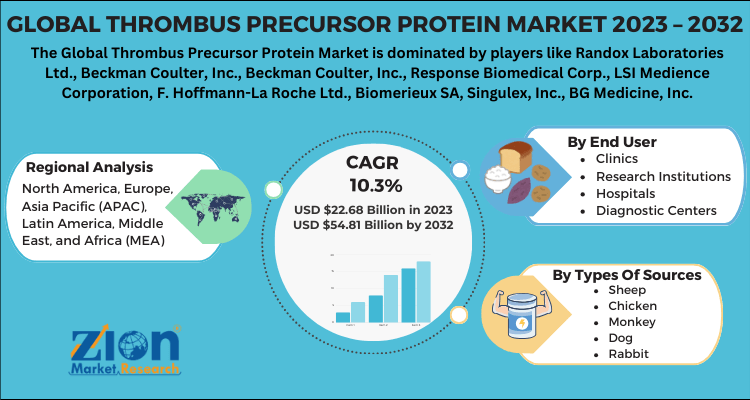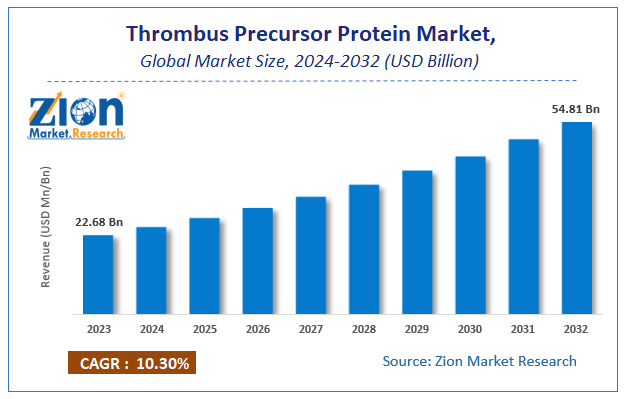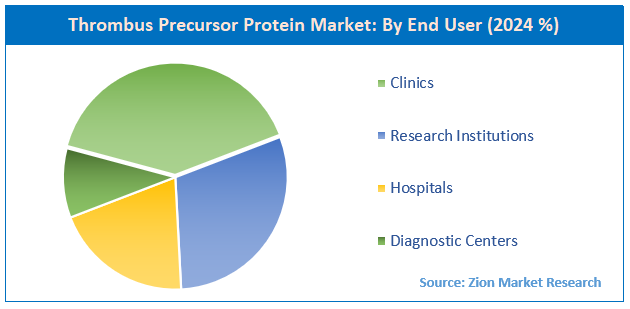Thrombus Precursor Protein Market Size, Share, Trends, Growth and Forecast 2032

Thrombus Precursor Protein Market By types of sources, (sheep, chicken, monkey, dog, rabbit, mouse, human, guinea pig, porcine, goat, and bovine), By end user (clinics, research institutions, hospitals, and diagnostic centers) And By Region: - Global And Regional Industry Overview, Market Intelligence, Comprehensive Analysis, Historical Data, And Forecasts, 2024-2032
| Market Size in 2023 | Market Forecast in 2032 | CAGR (in %) | Base Year |
|---|---|---|---|
| USD 22.68 Billion | USD 54.81 Billion | 10.3% | 2023 |
Description
Thrombus Precursor Protein Market Insights
According to the report published by Zion Market Research, the global Thrombus Precursor Protein Market size was valued at USD 22.68 Billion in 2023 and is predicted to reach USD 54.81 Billion by the end of 2032. The market is expected to grow with a CAGR of 10.3% during the forecast period. The report analyzes the global Thrombus Precursor Protein Market's growth drivers, restraints, and impact on demand during the forecast period. It will also help navigate and explore the arising opportunities in the Thrombus Precursor Protein industry.
Key Insights:
- As per the analysis shared by our research analyst, the thrombus precursor protein market is anticipated to grow at a CAGR of 10.3% during the forecast period (2024-2032).
- The global thrombus precursor protein market was estimated to be worth approximately USD 22.68 billion in 2023 and is projected to reach a value of USD 54.81 billion by 2032.
- The growth of the thrombus precursor protein market is being driven by increasing prevalence of cardiovascular diseases, lifestyle-related disorders, and the growing need for preventive healthcare solutions.
- Based on the types of sources, the sheep segment is growing at a high rate and is projected to dominate the market.
- On the basis of end user, the clinics segment is projected to swipe the largest market share.
- By region, North America is expected to dominate the global market during the forecast period.
Global Thrombus Precursor Protein Market: Overview
One of the components of the fibrinolytic and coagulation pathways is the thrombus precursor protein (TpP). The thrombus precursor protein acts as a biomarker that specifies the exposure of the people to serious cardiovascular diseases, especially that are associated with the occlusion of the coronary blood vessels. The high levels of TpP indicate that there will be more production of the insoluble fibrin which will lead to the formation of the clot.
Global Thrombus Precursor Protein Market: Segmentation
The market for the thrombus precursor is globally fragmented into types of sources and end user.
On the basis of Types of Sources, the global market is segregated into sheep, chicken, monkey, dog, rabbit, mouse, human, guinea pig, porcine, goat, and bovine.
On the basis of End User, the market is categorized into clinics, research institutions, hospitals, and diagnostic centers.
Global Thrombus Precursor Protein Market: Growth Factors
The increase in the cases of the patients suffering from cardiac diseases is the major factor that is contributing to the thrombus precursor protein market. The major reasons that increase the chances of the heart diseases are high level of cholesterol, high blood pressure, overweight and obesity, diabetes, physical inactivity, poor diet, and excessive smoking and alcohol use. Other factors that are contributing to the market growth are rise in the geriatric population and the increasing awareness about the diagnostics among the people. The factors that may affect the growth of the thrombus precursor market are lack of awareness among the people in the under-developed regions and lack of the availability of these novel applications.
Recent Developments
- In March 2021, PerkinElmer bolstered its diagnostic capabilities by acquiring Oxford Immunotec, a leader in developing proprietary test kits for latent tuberculosis.
- In July 2021, PerkinElmer announced its intention to expand its life science portfolio by entering into a definitive agreement to acquire antibody and reagent provider BioLegend.
- In December 2021, Thermo Fisher Scientific enhanced its bioproduction offerings with the completed acquisition of recombinant protein specialist PeproTech.
- In July 2025, Novartis strengthened its pipeline for genetic diseases by completing the acquisition of Regulus Therapeutics and its promising RNA-based therapy for kidney disease.
- In July 2025, Merck KGaA significantly expanded its oncology presence through the completed acquisition of SpringWorks Therapeutics, gaining a portfolio of targeted treatments for rare tumors.
 Request Free Sample
Request Free Sample
Thrombus Precursor Protein Market: Report Scope
| Report Attributes | Report Details |
|---|---|
| Report Name | Thrombus Precursor Protein Market |
| Market Size in 2023 | USD 22.68 Billion |
| Market Forecast in 2032 | USD 54.81 Billion |
| Growth Rate | CAGR of 10.3% |
| Number of Pages | 211 |
| Key Companies Covered | Randox Laboratories Ltd., Beckman Coulter, Inc., Beckman Coulter, Inc., Response Biomedical Corp., LSI Medience Corporation, F. Hoffmann-La Roche Ltd., Biomerieux SA, Singulex, Inc., BG Medicine, Inc., and Alere, Inc |
| Segments Covered | By sources, By end user and By Region |
| Regions Covered | North America, Europe, Asia Pacific (APAC), Latin America, Middle East, and Africa (MEA) |
| Base Year | 2023 |
| Historical Year | 2018 to 2022 |
| Forecast Year | 2024 - 2032 |
| Customization Scope | Avail customized purchase options to meet your exact research needs. Request For Customization |
Thrombus Precursor Protein Market dynamics :
Key growth drivers
The Thrombus Precursor Protein (TpP) market is primarily driven by the rising global prevalence of cardiovascular diseases, including deep vein thrombosis (DVT), pulmonary embolism (PE), and stroke. As a valuable biomarker for assessing clot formation risk, TpP is gaining increased relevance in diagnostic labs, hospitals, and research settings. The aging and obese global population is a significant contributor to the increasing incidence of thrombotic conditions, creating a sustained demand for diagnostic tools and treatments. Furthermore, the growing emphasis on early and accurate disease detection, coupled with advancements in assay technologies that offer enhanced sensitivity and rapid, point-of-care formats, are boosting the clinical adoption of TpP testing.
Restraints
Despite the clear demand, the TpP market faces several key restraints. A major challenge is the lack of widespread awareness and standardized clinical guidelines for using TpP as a diagnostic marker in routine practice. This can limit its adoption compared to more established biomarkers. Furthermore, the high cost of specialized diagnostic kits and analytical equipment can be a significant barrier, particularly in developing regions with limited healthcare budgets. Another challenge is the inherent complexity of biological samples, as various factors can influence protein levels, potentially leading to inaccurate results and a need for highly skilled lab personnel to interpret the data correctly.
Opportunities
The market presents numerous opportunities for future growth and innovation. The increasing demand for personalized medicine offers a significant opportunity, as TpP can help identify patients at an increased risk of blood clots, allowing for tailored and more effective treatment plans. The development of more user-friendly, rapid, and cost-effective point-of-care diagnostic devices can expand the market to smaller clinics and even at-home testing. Furthermore, continuous research and development in proteomic technologies may lead to the discovery of new, more specific biomarkers related to thrombus formation, creating new product and therapeutic avenues. Expanding the market into emerging economies with improving healthcare infrastructure and a growing patient base also offers significant growth potential.
Challenges
The market is also confronted with a number of challenges that can hinder its full potential. The validation and qualification of new protein biomarkers are a complex and time-consuming process, with a need for robust clinical data to gain regulatory approval. This requires significant investment and collaboration between academic researchers, diagnostic companies, and regulatory bodies. The lack of a unified, global regulatory framework for biomarker use and a shortage of skilled professionals in proteomics and diagnostics are additional hurdles. Finally, while TpP is a promising biomarker, the presence of other, unidentified risk factors for cardiovascular events means there is a continuous need for research to ensure its accuracy and relevance as a primary diagnostic tool.
Global Thrombus Precursor Protein Market: Regional Analysis
The geographical diversification of the market for the thrombus precursor protein is given by North America, Latin America, the Middle East & Africa, Western Europe, Eastern Europe, and Asia Pacific. The North America region is presently dominating the global thrombus precursor protein market. This is due to the fact that the U.S. has an increased amount of patient population that is at a risk of cardiac conditions. According to the Data of Centers for Disease Control and Prevention, USA, approximately half of the population has at least one of the risk factors that may lead to heart diseases.
After North America, it is Europe that is capturing a good market share in the global thrombus precursor protein. The factor that the cases of the cardiovascular diseases have increased dramatically which has caused deaths has triggered the market in this region. The regions such as Asia Pacific and Latin America will also experience a rapid growth in the market due to increased death rates of patients suffering from cardiovascular diseases due to lack of awareness among the people, poor healthcare services, and absence of governmental policies.
Global Thrombus Precursor Protein Market: Competitive Players
The key market players that are involved in the thrombus precursor protein market include:
- Randox Laboratories Ltd.
- Beckman Coulter, Inc.
- Beckman Coulter, Inc.
- Response Biomedical Corp.
- LSI Medience Corporation
- F. Hoffmann-La Roche Ltd.
- Biomerieux SA
- Singulex, Inc.
- BG Medicine, Inc.
- Alere, Inc.
The Global Thrombus Precursor Protein Market is segmented as follows:
By Types of Sources
- Sheep
- Chicken
- Monkey
- Dog
- Rabbit
- Mouse
- Human
- Guinea pig
- Porcine
- Goat
- Bovine
By End User
- Clinics
- Research Institutions
- Hospitals
- Diagnostic Centers
Global Thrombus Precursor Protein Market: Regional Segment Analysis
- North America
- U.S.
- Europe
- UK
- France
- Germany
- Asia Pacific
- China
- Japan
- India
- Latin America
- Brazil
- Middle East and Africa
What Reports Provides
- Full in-depth analysis of the parent market
- Important changes in market dynamics
- Segmentation details of the market
- Former, on-going, and projected market analysis in terms of volume and value
- Assessment of niche industry developments
- Market share analysis
- Key strategies of major players
- Emerging segments and regional markets
- Testimonials to companies in order to fortify their foothold in the market.
Table Of Content
FrequentlyAsked Questions
Based on statistics from the Zion Market Research, the global Thrombus Precursor Protein Market size was projected at approximately US$ 22.68 Billion in 2023. Projections indicate that the market is expected to reach around US$ 54.81 Billion in revenue by 2032.
The global Thrombus Precursor Protein Market is expected to grow at a Compound Annual Growth Rate (CAGR) of around 10.3% during the forecast period from 2024 to 2032.
North America is expected to dominate the global Thrombus Precursor Protein Market.
The global Thrombus Precursor Protein Market is driven by several key factors such as; rising demand for fresh and organic produce, population growth, and health-conscious consumer preferences.
Some of the prominent players operating in the global Thrombus Precursor Protein Market are; Randox Laboratories Ltd., Beckman Coulter, Inc., Beckman Coulter, Inc., Response Biomedical Corp., LSI Medience Corporation, F. Hoffmann-La Roche Ltd., Biomerieux SA, Singulex, Inc., BG Medicine, Inc., and Alere, Inc
The global Thrombus Precursor Protein Market report provides a comprehensive analysis of market definitions, growth factors, opportunities, challenges, geographic trends, and competitive dynamics.
HappyClients
Zion Market Research
Tel: +1 (302) 444-0166
USA/Canada Toll Free No.+1 (855) 465-4651
3rd Floor,
Mrunal Paradise, Opp Maharaja Hotel,
Pimple Gurav, Pune 411061,
Maharashtra, India
Phone No +91 7768 006 007, +91 7768 006 008
US OFFICE NO +1 (302) 444-0166
US/CAN TOLL FREE +1 (855) 465-4651
Email: sales@zionmarketresearch.com
We have secured system to process your transaction.
Our support available to help you 24 hours a day, five days a week.
Monday - Friday: 9AM - 6PM
Saturday - Sunday: Closed






